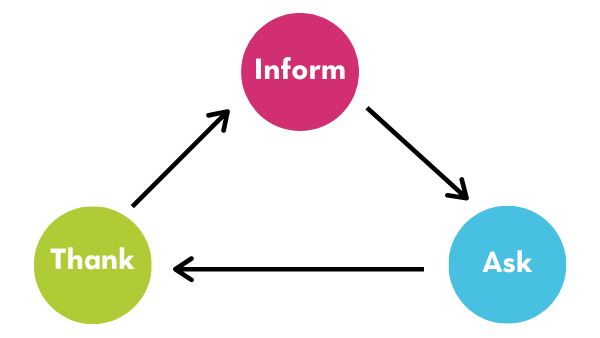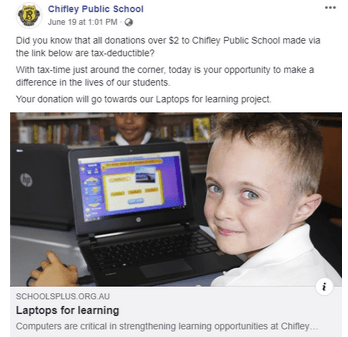Social media is a great way to share your project beyond your immediate school community (e.g. teachers, students and P&C). Parents, past students and other community members may connect with your school through social media channels such as Facebook, Instagram and Twitter. It is a simple, quick and free way to let your community know that your school needs support. The more people that know about your project, the more potential donors you have.
Through social media, you can build awareness about your fundraising, ask for donations and show gratitude to your current supporters. It’s important to take your audience on a journey by posting engaging content frequently. Be sure to mix up the content and avoid solely asking for donations. The below infographic shows a 3-step cycle that can help you plan posts.

Inform
Tell the story of your project. What is the problem you’re trying to solve? Why are you raising funds? Who will this project benefit? What positive change will occur within the school?
Example: ‘Students have lost interest in our school library. To reinvigorate this space and bring students back to the library, we aim to raise $20,000. Funds raised will buy 3D printers, virtual reality goggles and digital whiteboards.’
Ask
With online giving growing each year, using social media to ask for donations is becoming the norm. Your post should make the potential donor feel like the champion of your project. Make sure they know the impact of their potential donation on the school.
Example: ‘This project is only possible with your support. Your generous $100 donation will buy digital technology and re-engage students. Generations of future students will thank you for your support.’

Chifley Public School
Social media helped Chifley Public run a successful end of financial year fundraising campaign. Through the post below, we can see how (1) inform and (2) ask can be combined to create a single post. The post informs about the tax-deductible status of each gift and then asks for donations.
Thank
Show your appreciation for donors and celebrate campaign milestones. This will make current donors feel great and encourage those yet to give.
Example: ‘A big thank you to the generous staff at XYZ business. They have raised $2000 for our school. With this added support, we are now $1000 away from our fundraising goal.’

Murray Bridge High School
Murray Bridge High used their school Facebook page to show their gratitude to their recent donors. The post collectively (3) thanks their community and names significant donors. The school posted on the very last day of their fundraising campaign to create urgency and encourage last minute donations.
Images and video are another way to bring your project to life. You don’t need to be a graphic designer or videographer to create eye-catching content. There are many online resources that can help – Canva is my favourite. Canva is a free and simple graphic design tool. Think Photoshop – but with simplified tools. You’ll pick it up in less than five minutes.
Would you like to learn more? Check out the free Schools Plus Guide to Social Media and Fundraising. Here you’ll find more information about:
- Where to share your social media content (not just your school Facebook page!)
- The best day and time to post on social media
- Content planning ideas